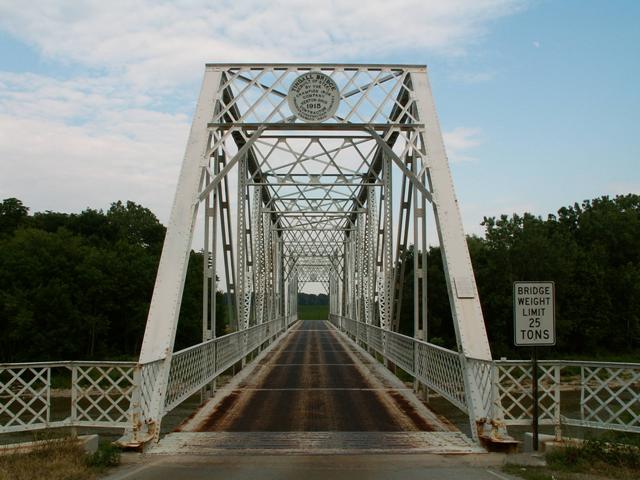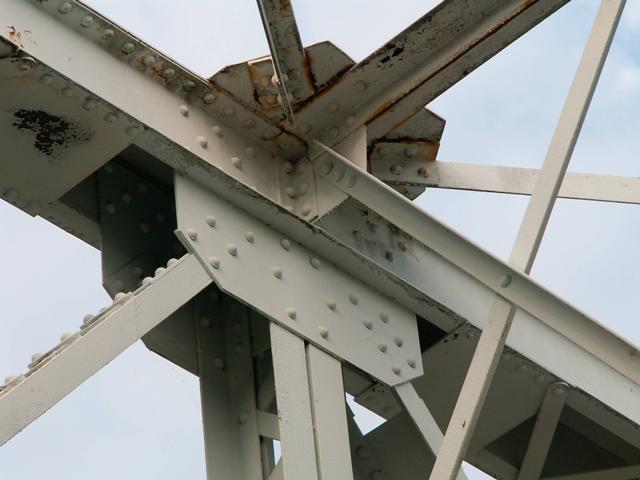We Recommend:
Bach Steel - Experts at historic truss bridge restoration.
BridgeHunter.com Phase 1 is released to the public! - Visit Now
Tindall Bridge

Primary Photographer(s): Nathan Holth and Rick McOmber
Bridge Documented: June 24, 2007
Rural: Sandusky County, Ohio: United States
1915 By Builder/Contractor: Champion Iron Company of Kenton, Ohio
Not Available or Not Applicable
166.0 Feet (50.6 Meters)
332.0 Feet (101.2 Meters)
15.7 Feet (4.79 Meters)
2 Main Span(s)
7230168

View Information About HSR Ratings
Bridge Documentation
View Archived National Bridge Inventory Report - Has Additional Details and Evaluation
The Tindall Bridge is a bridge that was built in 1915, but its attractive plaque proudly crediting its builders with reconstructing the crossing with a steel bridge perhaps creates images of the 1880s. The Champion Iron Company certainly did build a bridge worthy of pride. The bridge has been maintained well and today is still posted with a generous 25 ton weight limit, which is more than sufficient for the light vehicular traffic that travels Rice Road.
This bridge retains original lattice railings, which are interesting because they are present beyond the truss itself and onto the abutments. This practice is often found over in Ontario, but not elsewhere.
The bridge, with its two spans, each of decent length is a very attractive structure and well worth continued maintenance and preservation. The white paint currently on the bridge enhances the appearance of the bridge and reflects a color choice that was commonly used on bridges in the past, because it showed rust more readily, easing the difficulty of maintenance.
Information and Findings From Ohio's Historic Bridge InventorySetting/Context The bridge carries a 1 lane road over a stream in a sparsely developed, rural setting. There is a curve on the east end and a T intersection at the west end. Physical Description The 2 span, 332'-long rivet-connected Pratt thru truss bridge supported on concrete substructure units is traditionally composed of built-up members. It has deep lattice portal braces with an oversize builders plaque and lattice railings inside the truss lines. The open grid deck is modern. Otherwise the bridge appears to be complete. Integrity The bridge has been rehabilitated by the county. Summary of Significance The riveted Pratt pony[sic] truss bridge was placed in 1915. It is fairly complete example of its type, but it is not an early example nor does it have innovative or distinctive details. Extant riveted truss
bridges in Ohio date to the turn of the 20th century, and it is the early examples that chronicle the historical and technological significant of the design. Bridge Considered Historic By Survey: No |
![]()
Photo Galleries and Videos: Tindall Bridge
Original / Full Size Gallery
Original / Full Size PhotosFor the best visual immersion and full detail, or for use as a desktop background, this gallery presents selected overview and detail photos for this bridge in the original digital camera resolution. This gallery offers photos in the highest available resolution and file size in a touch-friendly popup viewer.
Alternatively, Browse Without Using Viewer
![]()
Structure Overview
Mobile Optimized PhotosA collection of overview photos that show the bridge as a whole and general areas of the bridge. This gallery features data-friendly, fast-loading photos in a touch-friendly popup viewer.
Alternatively, Browse Without Using Viewer
![]()
Structure Details
Mobile Optimized PhotosA collection of detail photos that document the parts, construction, and condition of the bridge. This gallery features data-friendly, fast-loading photos in a touch-friendly popup viewer.
Alternatively, Browse Without Using Viewer
![]()
Maps and Links: Tindall Bridge
Coordinates (Latitude, Longitude):
Search For Additional Bridge Listings:
Bridgehunter.com: View listed bridges within 0.5 miles (0.8 kilometers) of this bridge.
Bridgehunter.com: View listed bridges within 10 miles (16 kilometers) of this bridge.
Additional Maps:
Google Streetview (If Available)
GeoHack (Additional Links and Coordinates)
Apple Maps (Via DuckDuckGo Search)
Apple Maps (Apple devices only)
Android: Open Location In Your Map or GPS App
Flickr Gallery (Find Nearby Photos)
Wikimedia Commons (Find Nearby Photos)
Directions Via Sygic For Android
Directions Via Sygic For iOS and Android Dolphin Browser
USGS National Map (United States Only)
Historical USGS Topo Maps (United States Only)
Historic Aerials (United States Only)
CalTopo Maps (United States Only)




